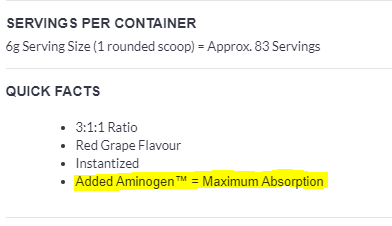I give you an example of a BCAA product that contains an added “cutting-edge” ingredient which doesn’t serve any purpose.
The supplement business is no doubt very competitive today. Companies are running out of ideas to make their products stand out from the competition.
For instance, label designers don’t have much options to make labels stand out. We’ve seen all sorts of supplement labels trends: simplistic, busy, shiny, with half-naked bodies, with ghosts and skulls, cartoon characters, and lately psychedelic-type designs, you name it.
It is really difficult to stand out!
Enter “cutting-edge” ingredients
One of the things that some companies do is include some sort of “trump card” ingredients into their formulations. They do so as a means to create a unique selling point for their product and brand. This makes them look cutting-edge and scientific.
It is all good if the added ingredients actually benefit the consumer.
Unfortunately, such is not always the case. Some brands are up to no good.
Here are 3 scenarios:
- Use of ineffective ingredients: most of “cutting-edge” ingredients used are relatively new and are not proven effective. They will be cutting edge today and gone tomorrow, like raspberry ketones, etc.
- Use of effective ingredients in tiny doses: e.g. a “superfood enriched” vegetable protein that contains a few grams of almond flour. This very likely improves the texture but provides little by means of added nutrition. Almond may be a “superfood” but a few grams is unlikely to be of any nutritional significance. I once queried a brand owner about the nutritional significance of the added “superfoods” (almond flour) and he got really defensive and personal. He was someone I looked up to and his answer really disappointed me.
- Use of effective ingredients in the wrong contexts: an example of which we will be looking at below.
Well, some time back I came across this BCAA product from a South African brand. It claims to have an added enzyme called Aminogen™ for maximum absorption.
Below is a screenshot from their website:

What is also claimed on their website regarding Aminogen is:
“AminogenTM is a patented, plant based, proteolytic (protein digesting) enzyme. It dramatically increases the absorption rate of amino acids by 220-350%, raises blood levels of BCAA’s by 250%, and nitrogen retention by 32%. AminogenTM significantly optimises the availability of BCAA’s as cellular substrates for progressive muscle hypertrophy, enhanced post-training recovery, proficient nervous system function and strengthened immunity”
What is the problem with this?
Aminogen™ is an enzyme that digests protein. When added to a protein supplement it helps with its digestion. This means that is breaks down proteins into the simpler absorbable amino acid units.
Digestive enzymes are often added to protein shakes. However, it may be argued that for whey protein which is among the easiest-digesting proteins, there isn’t really need for added enzymes to help with protein digestion?
Aminogen™ may be helpful in individuals with digestive impairments.
But the question here is:
Is Aminogen™ necessary in a product that contains entirely free-form amino acids? The answer is NO. Because there simply isn’t anything to digest further. End of story.
What about the increased BCAA absorption mentioned above, then?
Well, when the makers of Aminogen™ tested their enzyme, they got subjects to consume it along with a whole protein. They then measured the rate of release of amino acids as a result of the activity of the enzyme in breaking down the whole protein. They publicised the BCAA-release data instead of, say Glycine. They know that bodybuilders love BCAAs and improved BCAA absorption is music to the ears!
They did not add Aminogen™ to a free-form BCAA product and saw improved BCAA absorption. The improved BCAA absorption is only when the enzyme is added to a whole protein.
The product formulators either:
- Got it all wrong by not understanding the role of the enzyme or
- Know their Biology, but instead chose to mislead consumers with a unique selling point that is of no benefit to them.
The take-home lessons
- In some cases, these “added ingredients” are of no benefit to you.
- It always helps to do a little research when making a purchasing decision. Do this especially when you see claims about a specific ingredient and you are being charged more for this extra ingredient.
- When in doubt about something it is good to seek a second opinion. I have guided many people in making the right shopping choices. This spared them a lot of cash while getting them results.
Thanks a lot for reading this article. If you like it please share it!

To view my Professional Profile on LinkedIn: please click here
To see my latest product creations: www.bioteenhealth.com
To view my Scientific Publications on PubMed: please click here
To get in touch, please write to: info@supplementscientist.com
Follow supplementscientist.com on Facebook: please click here
Medical disclaimer
The information presented on this website is intended for adults 18 or over. Its aim is purely educational and does not constitute medical advice. Please consult a medical or health professional before you begin any program related to exercise, nutrition, or supplementation especially if you have a medical condition. If you consume any product mentioned on our site, you do so on your own free will, and you knowingly and voluntarily accept the risks. © 2023. Supplementscientist.com







Leave a Reply